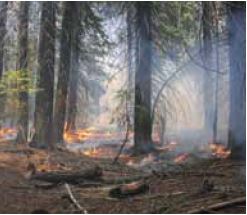 Current Sierra Nevada forest management is often focused on strategically reducing
Current Sierra Nevada forest management is often focused on strategically reducing
fuels without an explicit strategy for ecological restoration across the landscape
matrix. Summarizing recent scientific literature, we suggest managers produce
different stand structures and densities across the landscape using topographic
variables (i.e., slope shape, aspect, and slope position) as a guide for varying
treatments. Local cool or moist areas, where historically fire would have burned
less frequently or at lower severity, would have higher density and canopy cover,
providing habitat for sensitive species. In contrast upper, southern-aspect slopes
would have low densities of large fire-resistant trees. For thinning, marking rules
would be based on crown strata or age cohorts and species, rather than uniform
diameter limits. Collectively, our management recommendations emphasize the
ecological role of fire, changing climate conditions, sensitive wildlife habitat, and
the importance of forest structure heterogeneity.
View the full report here: https://www.fs.fed.us/psw/publications/documents/psw_gtr220/psw_gtr220.pdf